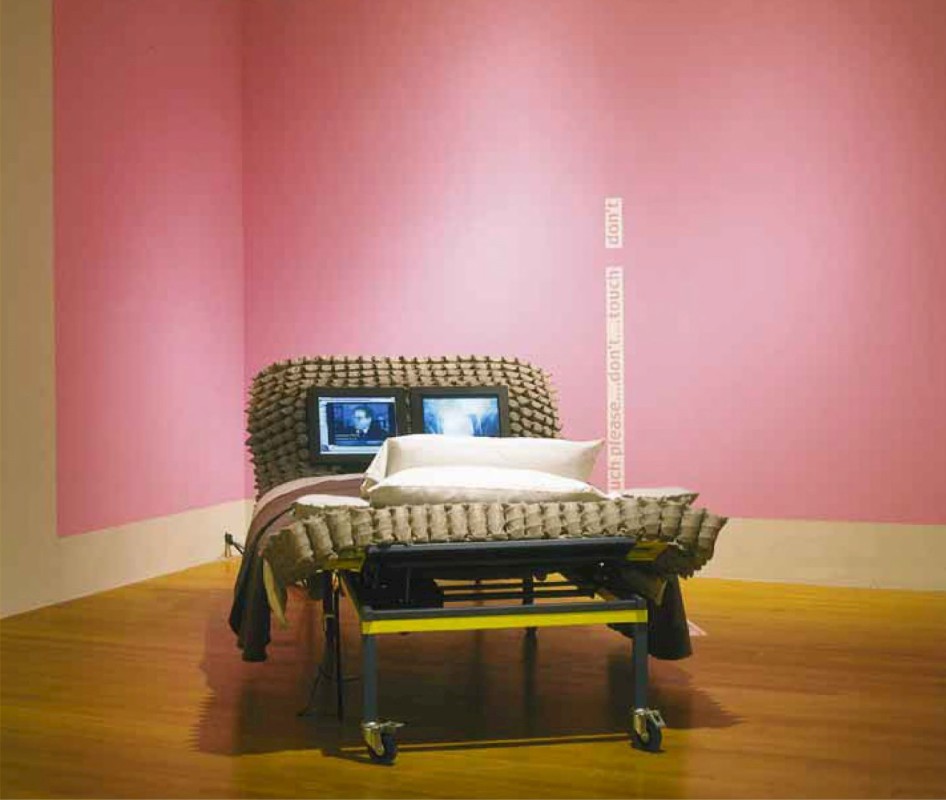Smart surfaces, interactive beds, couches for web surfing, clothing for self-isolation, fully integrated units/furniture – something between garden sofas and mobile offices – total atmospheres and, once again, environments.
After the hangover of the Internet era, when past the global Millennium Bug panic we began to look for shapes in space for the post-dot-com society, the battle cry of the 2000s seemed to be “everything but the office”. The workspace was deconstructed, increasing its immaterial component and anticipating digital nomadism and smart working. Starting from two U.S. exhibitions, one in New York at MoMA and the other at the National Building Museum in Washington DC, with a review-essay on Domus 836 dating back to June 2001, anthropologist Jan Abrams explored places and forms of a changing design field.
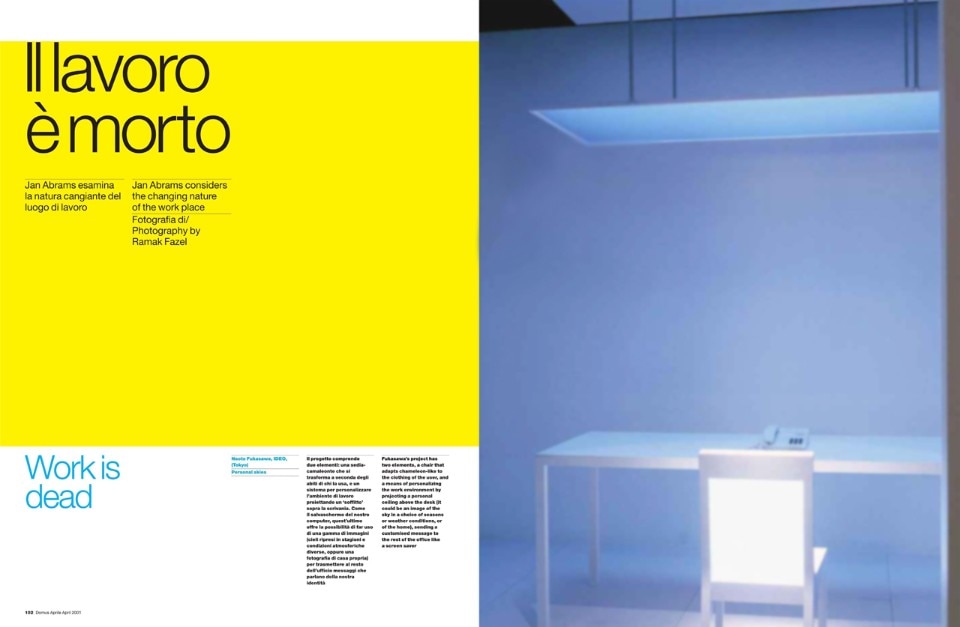
Work is dead
An anthropologist wanting to know about early twenty-first century work behavior would be well advised to visit the Duty Free electronics counters at Schiphol airport where, beautifully arranged in elegant glass cabinets, the armaments of the contemporary “road warrior” are on regularly-updated display. Jewel-like, mesmerisingly tiny, curvaceous, and offered in an entomological array of metallic hues, the latest cell phones, personal digital assistants, folding keyboards, minidisc recorders, MP3 players and other communications regalia are laid out, as delectable as Fabergé eggs in a museum showcase. For a rather less alluring but perhaps more instructive field trip, our anthropologist would need to enter a branch of Staples, or OfficeMax. These garish U.S. high-street warehouses – truly some of the “representative environments” of our retail era – are compendia of all things office. From plastic in-trays to fluorescent Post-It notes, from squidgy computer keyboard wrist supports to paper shredders and file folders by the bushel, their groaning aisles and industrial-strength shelving speak volumes about the commodification of everyday work. Here, bulk-purchase discounts count for far more than beauty or the satisfaction to be derived from using well-designed equipment and supplies; “dignity of labor” be damned. Should these inventories of contemporary white-collar implements prove insufficiently enlightening, our anthropologist might appreciate two recently-opened U.S. museum exhibitions that tackle the past, present and future of workplace design.
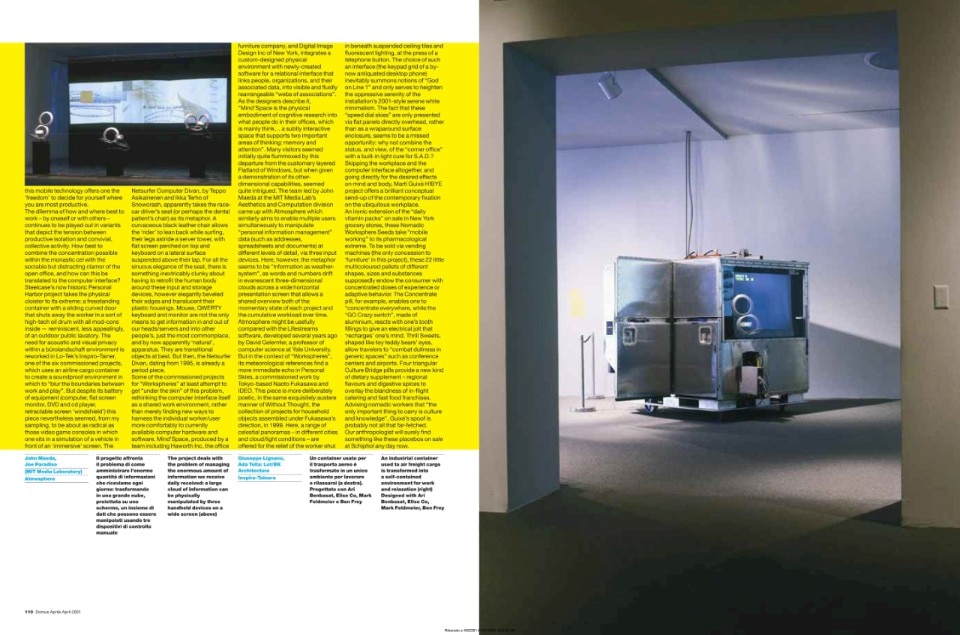
The concurrence of “Workspheres” at the Museum of Modern Art in New York, and “On the Job” at the National Building Museum in Washington DC would seem to indicate a sudden burst of curatorial interest in this realm of activity, albeit from differing perspectives. Given the much-hyped transformation of the work world due to the Internet, and the efflorescence of new communications gadgets over the past decade, the time is certainly ripe for a reexamination of the office, indeed, for a fundamental questioning of what work is these days. It is not entirely clear, however, that either of these shows – both quite long in the planning – truly addresses this latter question.
“Workspheres”, curated by Paola Antonelli (a Curator in MoMA’s Department of Architecture and Design) is an altogether seductive and enjoyable display of recent office furniture, computer hardware and peripherals, and mobile communication devices – including models already in commercial production and some “coming attractions” prototypes. Additionally, the show includes half a dozen specially commissioned projects, in which selected architects, industrial and software designers offer speculative meditations on the future work environment. In this exhibit, as in previous shows she has curated at MoMA (eg “Mutant Materials”, and “Achille Castiglioni”), Antonelli demonstrates perfect pitch in terms of the amount of stuff she puts on display in a given room.
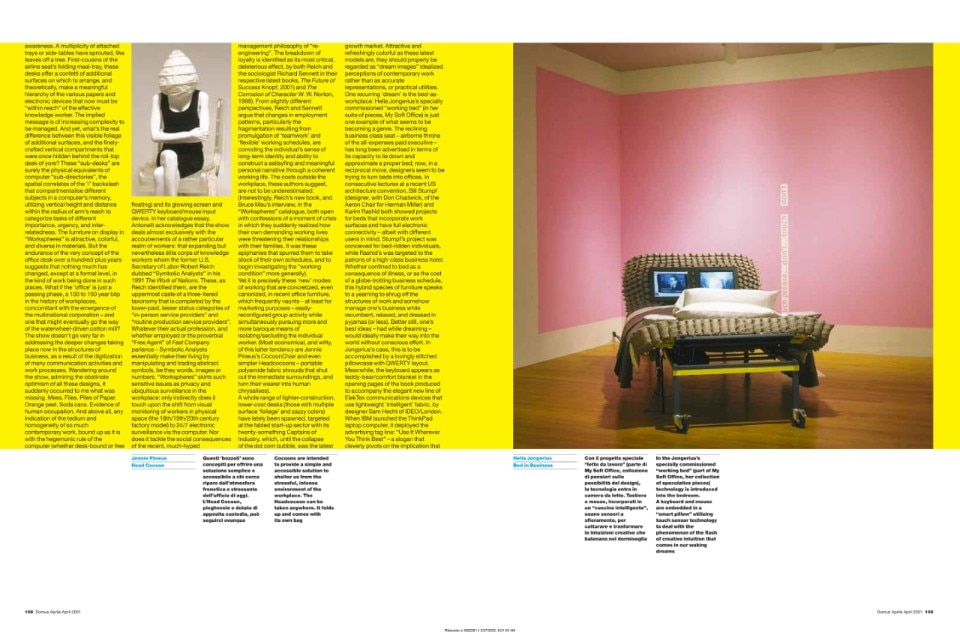
The placements of the exhibits, and the ‘breathing’ space allowed between and around them – often objects of very different scales – reflect an intuitive sense of how much a viewer can take in before they want to move on to ponder the next item. The lighting is exquisite, and the disposition of bold color (this being one of the most striking attributes of recent office furniture) handled with her customary finesse. Though they are grouped in the catalogue according to several types of work environments – from the “official office” to the ‘nomadic’, and with a section devoted to the individual workstation – the artefacts are mixed and mingled freely in the exhibit. On the show’s first day of public viewing, the galleries were healthily thronged, albeit that one or two of the interactive pieces were proving a little arcane for novice users.
“Workspheres” gathers products by a roll-call of international celebrity designers (including Eric Chan/ECCO (New York), Citterio and Löw, Ayse Birsel, Konstantin Grcic, Sam Hecht, Antenna Design, Snowcrash consortium) as well as several less well-known but nonetheless influential in-house designers at the major office furniture manufacturers. Changing attitudes to office work are calibrated in the newly liberated curvatures of desks, the vertebral expressionism of the latest ergonomic office chairs, the zesty play-chest look of roll-along filing cabinets; the sculptural voluptuousness of freestanding partitions. Surfaces undulate, desk tops roll into gentle curves instead of sharp edges; the materials are bright, colorful, translucent, shiny. Desk legs no longer descend respectfully vertical at the corners of the work surface, but bend out and down insect-like, often ending in castors (signifying potential mobility, if not imminent relocation). A shift from 90 degrees to 120 degrees in the angles of one particular system (Ayse Birsel’s Resolve system for Herman Miller) is presented as tantamount to a new industrial revolution. In several individual ‘workstations’ (what used to be the mere ‘desk’) the horizontal work surface is sheltered from adjacent workers by a nascent cave’ or cocoon-like structure of curving panels, decks that position different documents within one’s peripheral vision – and therefore, by implication, within one’s range of conscious awareness. A multiplicity of attached trays or side-tables have sprouted, like leaves off a tree. First-cousins of the airline seat’s folding meal-tray, these desks offer a confetti of additional surfaces on which to arrange, and theoretically, make a meaningful hierarchy of the various papers and electronic devices that now must be “within reach” of the effective knowledge worker.
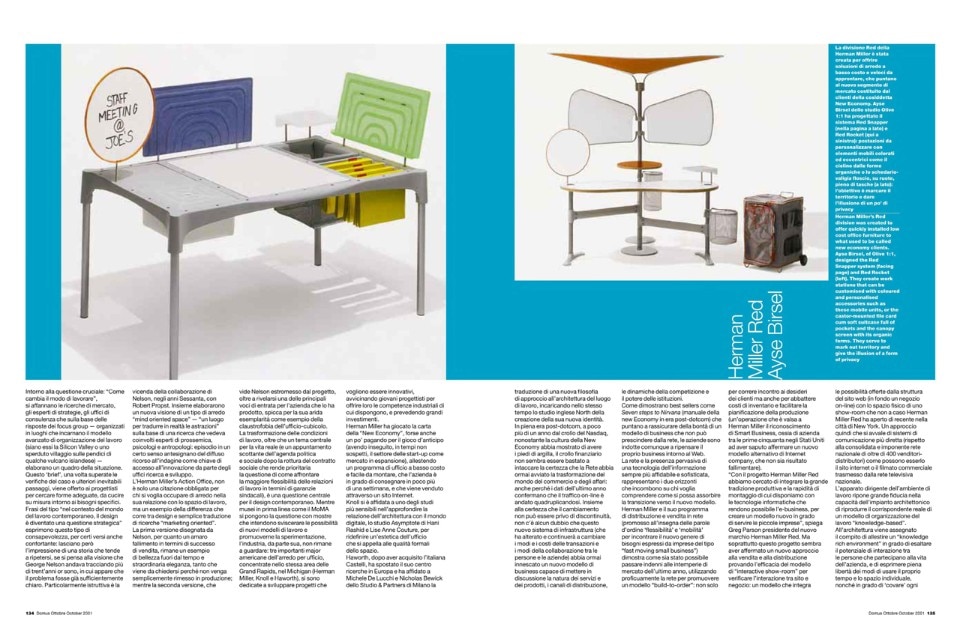
The implied message is of increasing complexity to be managed. And yet, what’s the real difference between this visible foliage of additional surfaces, and the finely-crafted vertical compartments that were once hidden behind the roll-top desk of yore? These “sub-desks” are surely the physical equivalents of computer “sub-directories”, the spatial correlates of the ‘/’ backslash that compartmentalise different subjects in a computer’s memory, utilizing vertical height and distance within the radius of arm’s reach to categorize tasks of different importance, urgency, and inter-relatedness. The furniture on display in “Workspheres” is attractive, colorful, and diverse in materials. But the endurance of the very concept of the office desk over a hundred-plus years suggests that nothing much has changed, except at a formal level, in the kind of work being done in such places. What if the ‘office’ is just a passing phase, a 100 to 150 year blip in the history of workplaces, concomitant with the emergence of the multinational corporation – and one that might eventually go the way of the waterwheel-driven cotton mill? The show doesn’t go very far in addressing the deeper changes taking place now in the structures of business, as a result of the digitization of many communication activities and work processes. Wandering around the show, admiring the obstinate optimism of all these designs, it suddenly occurred to me what was missing. Mess. Files. Piles of Paper. Orange peel. Soda cans. Evidence of human occupation. And above all, any indication of the tedium and homogeneity of so much contemporary work, bound up as it is with the hegemonic rule of the computer (whether desk-bound or free floating) and its glowing screen and QWERTY keyboard/mouse input device.
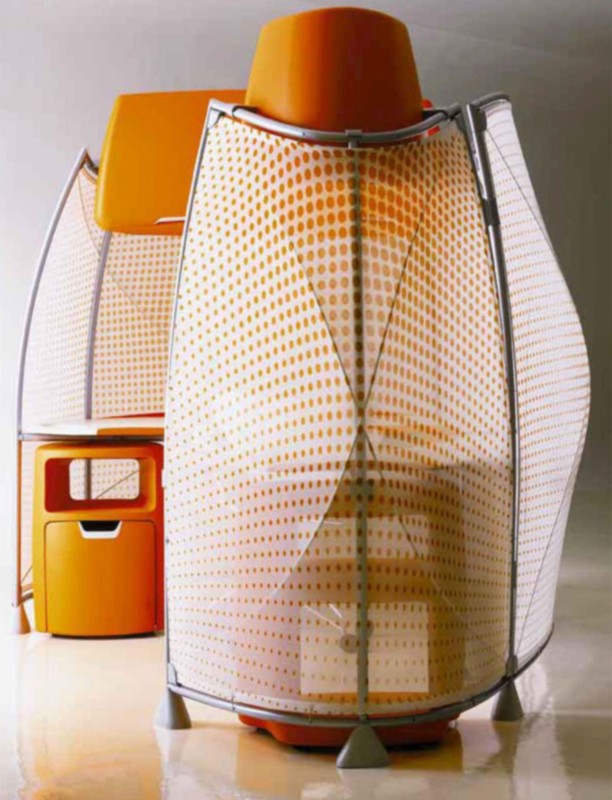
In her catalogue essay, Antonelli acknowledges that the show deals almost exclusively with the accoutrements of a rather particular realm of workers: that expanding but nevertheless élite corps of knowledge workers whom the former U.S. Secretary of Labor Robert Reich dubbed “Symbolic Analysts” in his 1991 The Work of Nations. These, as Reich identified them, are the uppermost caste of a three-tiered taxonomy that is completed by the lower-paid, lesser status categories of “in-person service providers” and “routine production service providers”. Whatever their actual profession, and whether employed or the proverbial “Free Agent” of Fast Company parlance – Symbolic Analysts essentially make their living by manipulating and trading abstract symbols, be they words, images or numbers.
“Workspheres” skirts such sensitive issues as privacy and ubiquitous surveillance in the workplace: only indirectly does it touch upon the shift from visual monitoring of workers in physical space (the 18th/19th/20th century factory model) to 24/7 electronic surveillance via the computer. Nor does it tackle the social consequences of the recent, much-hyped management philosophy of “re-engineering”. The breakdown of loyalty is identified as its most critical, deleterious effect, by both Reich and the sociologist Richard Sennett in their respective latest books, The Future of Success Knopf, 2001) and The Corrosion of Character W. W. Norton, 1998). From slightly different perspectives, Reich and Sennett argue that changes in employment patterns, particularly the fragmentation resulting from promulgation of ‘teamwork’ and ‘flexible’ working schedules, are corroding the individual’s sense of long-term identity and ability to construct a satisyfing and meaningful personal narrative through a coherent working life. The costs outside the workplace, these authors suggest, are not to be underestimated. (Interestingly, Reich’s new book, and Bruce Mau’s interview, in the “Workspheres” catalogue, both open with confessions of a moment of crisis in which they suddenly realized how their own demanding working lives were threatening their relationships with their families. It was these epiphanies that spurred them to take stock of their own schedules, and to begin investigating the “working condition” more generally).
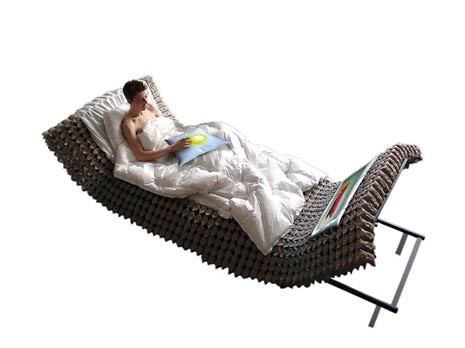
Yet it is precisely these ‘new’ modes of working that are concretized, even canonized, in recent office furniture, which frequently vaunts – at least for marketing purposes – easily-reconfigured group activity while simultaneously pursuing more and more baroque means of isolating/secluding the individual worker. (Most economical, and witty, of this latter tendency are Jennie Pineus’s CocoonChair and even simpler Headcocoons – portable polyamide fabric shrouds that shut out the immediate surroundings, and turn their wearer into human chrysalises). A whole range of lighter-construction, lower-cost desks (those with multiple surface ‘foliage’ and zazzy colors) have lately been spawned, targeted at the fabled start-up sector with its twenty-something Captains of Industry, which, until the collapse of the dot com bubble, was the latest growth market. Attractive and refreshingly colorful as these latest models are, they should properly be regarded as “dream images” idealized perceptions of contemporary work rather than as accurate representations, or practical utilities.
One recurring ‘dream’ is the bed-as-workplace: Hella Jongerius’s specially commissioned “working bed” (in her suite of pieces, My Soft Office) is just one example of what seems to be becoming a genre. The reclining business class seat – airborne throne of the all-expenses paid executive – has long been advertised in terms of its capacity to lie down and approximate a proper bed; now, in a reciprocal move, designers seem to be trying to turn beds into offices. In consecutive lectures at a recent US architecture convention, Bill Stumpf (designer, with Don Chadwick, of the Aeron Chair for Herman Miller) and Karim Rashid both showed projects for beds that incorporate work surfaces and have full electronic connectivity – albeit with different users in mind. Stumpf’s project was conceived for bed-ridden individuals, while Rashid’s was targeted to the patrons of a high-class business hotel. Whether confined to bed as a consequence of illness, or as the cost of a globe-trotting business schedule, this hybrid species of furniture speaks to a yearning to shrug off the structures of work and somehow manage one’s business while recumbent, relaxed, and dressed in pyjamas (or less). Better still, one’s best ideas – had while dreaming – would ideally make their way into the world without conscious effort. In Jongerius’s case, this is to be accomplished by a lovingly stitched pillowcase with QWERTY layout. Meanwhile, the keyboard appears as teddy-bear/comfort blanket in the opening pages of the book produced to accompany the elegant new line of ElekTex communications devices that use lightweight ‘intelligent’ fabric, by designer Sam Hecht of IDEO/London.
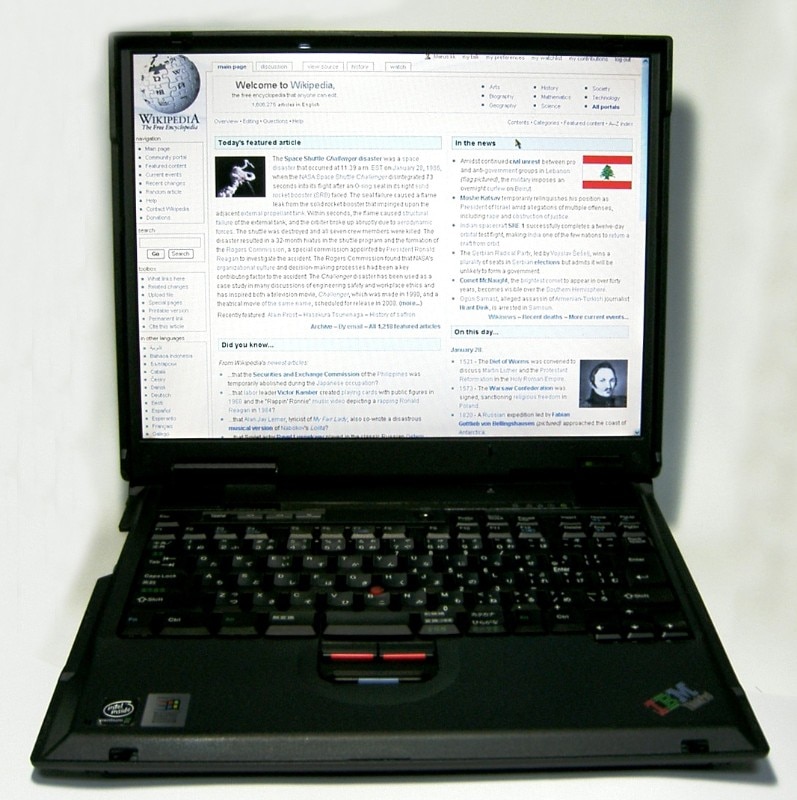
When IBM launched the ThinkPad laptop computer, it deployed the advertising tag line: “Use It Wherever You Think Best” – a slogan that cleverly pivots on the implication that this mobile technology offers one the ‘freedom’ to decide for yourself where you are most productive. The dilemma of how and where best to work – by oneself or with others – continues to be played out in variants that depict the tension between productive isolation and convivial, collective activity. How best to combine the concentration possible within the monastic cel with the sociable but distracting clamor of the open office, and how can this be translated to the computer interface? Steelcase’s now historic Personal Harbor project takes the physical cloister to its extreme: a freestanding container with a sliding curved door that shuts away the worker in a sort of high-tech oil drum with all mod-cons inside — reminiscent, less appealingly, of an outdoor public lavatory. The need for acoustic and visual privacy within a bürolandschaft environment is reworked in Lo-Tek’s Inspiro-Tainer, one of the six commissioned projects, which uses an airline cargo container to create a soundproof environment in which to “blur the boundaries between work and play”. But despite its battery of equipment (computer, flat screen monitor, DVD and cd player, retractable screen ‘windshield’) this piece nevertheless seemed, from my sampling, to be about as radical as those video game consoles in which one sits in a simulation of a vehicle in front of an ‘immersive’ screen.
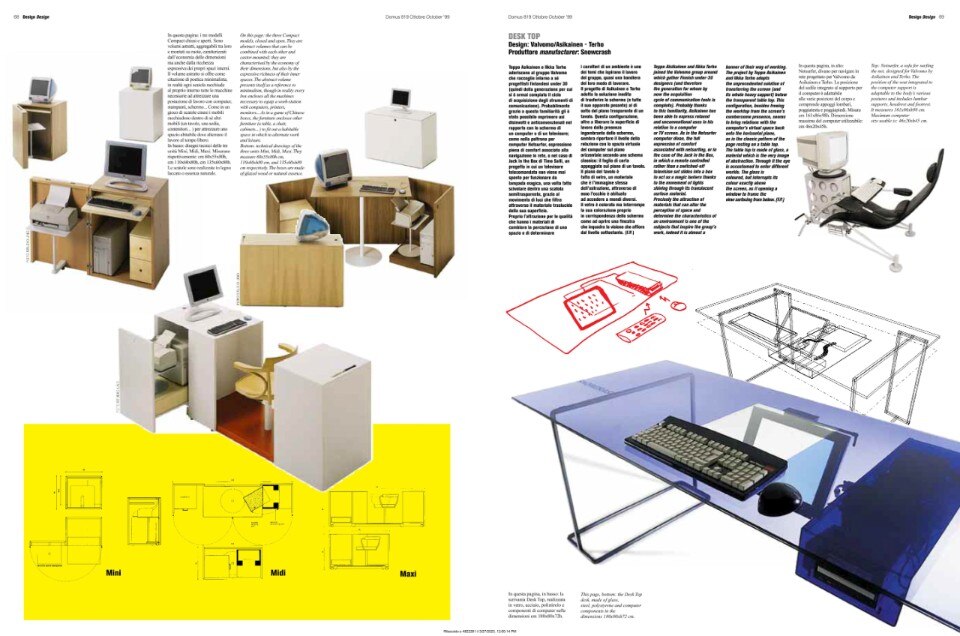
The Netsurfer Computer Divan, by Teppo Asikainenen and Ikka Terho of Snowcrash, apparently takes the race-car driver’s seat (or perhaps the dental patient’s chair) as its metaphor. A curvaceous black leather chair allows the ‘rider’ to lean back while surfing, their legs astride a server tower, with flat screen perched on top and keyboard on a lateral surface suspended above their lap. For all the sinuous elegance of the seat, there is something inextricably clunky about having to retrofit the human body around these input and storage devices, however elegantly beveled their edges and translucent their plastic housings. Mouse, QWERTY keyboard and monitor are not the only means to get information in and out of our heads/servers and into other people’s, just the most commonplace, and by now apparently ‘natural’, apparatus. They are transitional objects at best. But then, the Netsurfer Divan, dating from 1995, is already a period piece. Some of the commissioned projects for “Workspheres” at least attempt to get “under the skin” of this problem, rethinking the computer interface itself as a shared work environment, rather than merely finding new ways to harness the individual worker/user more comfortably to currently available computer hardware and software. Mind’Space, produced by a team including Haworth Inc, the office furniture company, and Digital Image Design Inc of New York, integrates a custom-designed physical environment with newly-created software for a relational interface that links people, organizations, and their associated data, into visible and fluidly rearrangeable “webs of associations”. As the designers describe it, “Mind’Space is the physical embodiment of cognitive research into what people do in their offices, which is mainly think… a subtly interactive space that supports two important areas of thinking: memory and attention”. Many visitors seemed initially quite flummoxed by this departure from the customary layered Flatland of Windows, but when given a demonstration of its other-dimensional capabilities, seemed quite intrigued. The team led by John Maeda at the MIT Media Lab’s Aesthetics and Computation division came up with Atmosphere which similarly aims to enable multiple users simultaneously to manipulate “personal information management” data (such as addresses, spreadsheets and documents) at different levels of detail, via three input devices. Here, however, the metaphor seems to be “information as weather-system”, as words and numbers drift in evanescent three-dimensional clouds across a wide horizontal presentation screen that allows a shared overview both of the momentary state of each project and the cumulative workload over time.
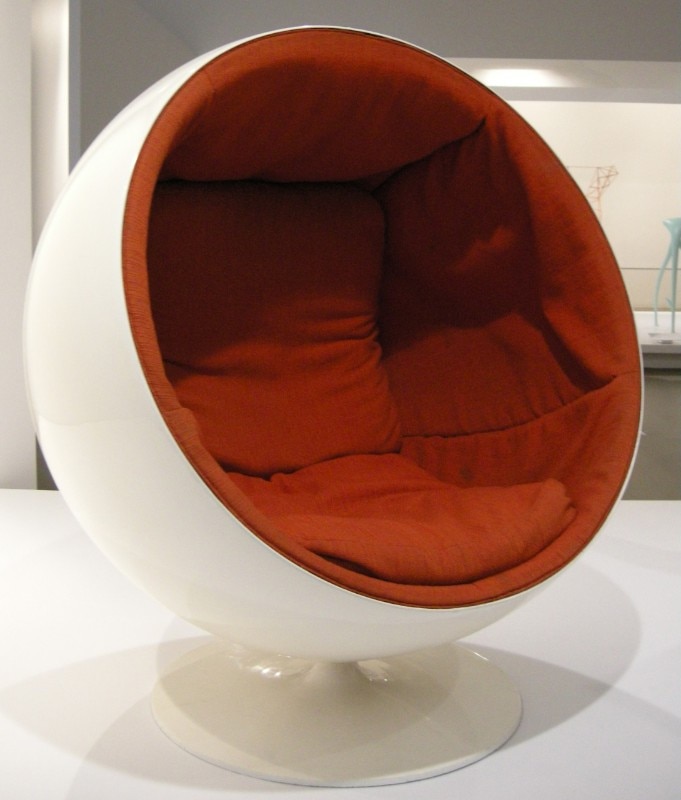
Atmosphere might be usefully compared with the Lifestreams software, developed several years ago by David Gelernter, a professor of computer science at Yale University. But in the context of “Workspheres”, its meteorological references find a more immediate echo in Personal Skies, a commissioned work by Tokyo-based Naoto Fukasawa and IDEO. This piece is more deliberately poetic, in the same exquisitely austere manner of Without Thought, the collection of projects for household objects assembled under Fukasawa’s direction, in 1999. Here, a range of celestial panoramas – in different cities and cloud/light conditions – are offered for the relief of the worker shut in beneath suspended ceiling tiles and fluorescent lighting, at the press of a telephone button. The choice of such an interface (the keypad grid of a by-now antiquated desktop phone) inevitably summons notions of “God on Line 1” and only serves to heighten the oppressive serenity of the installation’s 2001-style serene white minimalism. The fact that these “speed dial skies” are only presented via flat panels directly overhead, rather than as a wraparound surface enclosure, seems to be a missed opportunity: why not combine the status, and view, of the “corner office” with a built-in light cure for S.A.D.? Skipping the workplace and the computer interface altogether, and going directly for the desired effects on mind and body, Martí Guixé H!BYE project offers a brilliant conceptual send-up of the contemporary fixation on the ubiquitous workplace. An ironic extension of the “daily vitamin packs” on sale in New York grocery stores, these Nomadic Worksphere Seeds take “mobile working” to its pharmacological extreme. To be sold via vending machines (the only concession to ‘furniture’ in this project), these 22 little multicoloured pellets of different shapes, sizes and substances supposedly endow the consumer with concentrated doses of experience or adaptive behavior. The Concentrate pill, for example, enables one to “concentrate everywhere, while the “GO Crazy switch”, made of aluminium, reacts with one’s tooth fillings to give an electrical jolt that ‘recharges’ one’s mind. Thrill Sweets, shaped like toy teddy bears’ eyes, allow travelers to “combat dullness in generic spaces” such as conference centers and airports. Four triangular Culture Bridge pills provide a new kind of dietary supplement – regional flavours and digestive spices to overlay the blandness of in-flight catering and fast food franchises. Advising nomadic workers that “the only important thing to carry is culture and knowledge”, Guixé’s spoof is probably not all that far-fetched. Our anthropologist will surely find something like these placebos on sale at Schiphol any day now.


